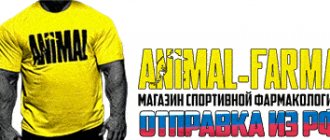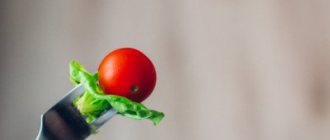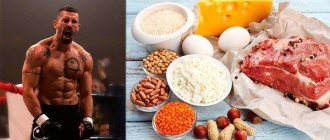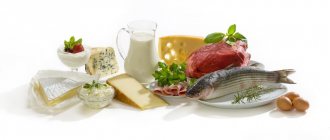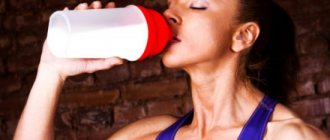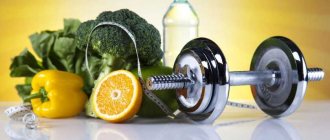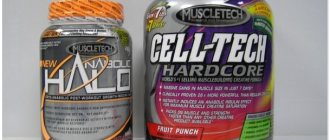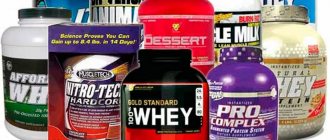The essence and rules of a sports diet
It switches the body to a constant calorie burning mode and helps you get into excellent physical shape. This is a fairly useful and convenient power supply system.
The principles of a sports diet consist of fractional meals, reducing body weight while limiting calories. The number of kilocalories should not exceed the calories expended by the body.
“Golden” rules of the sports nutrition system:
- In the morning, 30 minutes before meals, drink a glass of water on an empty stomach.
- Do not skip breakfast, as it gives a wake-up signal and provides the body with the necessary energy.
- Food should be fresh and natural.
- During the diet, you must definitely engage in sports (loads are selected individually).
- Eat frequently (about five times a day). Recent research suggests that after eating, the anabolic effect lasts for 3-4 hours, although amino acid levels remain elevated for a longer time. With this schedule, the digestive system is not overloaded. And the body is constantly saturated with useful substances that nourish the muscles.
- Eat at least an hour and a half before training and only two hours after it.
- To drink a lot of water. Metabolism during muscle growth is very intense, so a person needs a large amount of fluid to restore the necessary balance. The daily norm is 2.5-3 liters. Water should be either filtered tap water or bottled. A glass of water is drunk 20 minutes before the start of training, during which you should also take a couple of sips every 15 minutes.
- Limiting fats and fast carbohydrates.
- You can indulge in sweets only after training, when the body is able to quickly eliminate glucose.
- The portions of food eaten should be small.
- Food should be chewed thoroughly because this promotes better absorption.
- Perform physical activity regularly. You cannot skip workouts or do exercises poorly, otherwise all your efforts will be in vain.
- Count your calories every day.
By following these rules, you can see the result very quickly!
How to take sports nutrition to gain muscle mass
To ensure maximum effect from the use of nutritional supplements, you need to take them strictly at those moments when the beneficial substances from their composition will give the body maximum benefit.
Let's figure out when to take certain nutritional supplements:
Whey Protein
1st dose – immediately after sleep. At this time, the body needs to quickly get a charge of proteins to prevent catabolic processes in the muscles. Amount – 0.2 g/kg weight for men and 0.1 g/kg weight for women.
2nd dose – before training. In this way, we will provide the muscles with a stable supply of essential amino acids during the training process. Amount – 0.2 g/kg weight for men and 0.1 g/kg weight for women.
3rd dose – after training. The body uses the proteins obtained at this time as much as possible for the needs of muscle tissue. Amount – 0.4 g/kg weight for men and 0.2 g/kg weight for women.
Creatine
1st dose – before training. Necessary for maximum saturation of muscles with this component during the training process. Amount – 0.05 g/kg weight for men and 0.03 g/kg weight for women.
2nd dose – after training. Creatine taken at this time will ensure maximum muscle fiber growth. Amount – 0.05 g/kg weight for men and 0.03 g/kg weight for women.
Casein protein
1st dose – after training. The influx of slow proteins will ensure the continuity of recovery and growth of muscle tissue. Amount – 0.2 g/kg weight for men and 0.1 g/kg weight for women.
2nd dose – before bedtime. Slowly digestible proteins will protect muscle tissue from catabolic processes during the night's rest. Amount – 0.2 g/kg weight for men and 0.1 g/kg weight for women.
Glutamine
1st dose – after an overnight rest. Amount – 0.08 g/kg body weight for men. Women may not use it.
2nd dose – before training. The dosage is the same.
3rd dose – after training. The dosage is the same.
4th dose – an hour before going to bed in the same amount.
BCAA
1st dose – after an overnight rest. Amount – 0.09 g/kg weight for men and 0.04 g/kg weight for women.
2nd dose - before training in the same amount.
3rd dose – after training in the same dosage.
Arginine
1st dose - immediately after an overnight rest in the amount of 0.03 g/kg body weight for men and 0.01 g/kg body weight for women.
2nd dose - before training in the same dosage.
3rd dose – an hour before going to bed in the same amount.
Polyunsaturated fatty acids are taken with main meals 2 times a day.
Vitamins and antioxidants are taken according to the instructions for them or during main meals.
Sports diet for burning fat and gaining muscle mass, diet
Dietary nutrition for muscle growth requires compliance with certain recommendations:
- Fat burning will be more effective if 70% of food is consumed before 16 hours.
- Avoid fast carbohydrates, as they cause spikes in blood sugar and glucose is quickly converted into fat deposits. It is better to give preference to complex carbohydrates.
- Limiting the consumption of fatty foods such as sausages, lard, fatty meats, and so on. They do not contribute to muscle growth, but are stored in fat.
- Avoid congestion of the digestive tract. To do this, the food consumed must be well digestible. The optimal diet is two-thirds high-calorie foods and one-third with plant fiber.
- Before going to bed, give preference to protein foods.
- Special physical training.
- The diet should contain 60% carbohydrates, 30% proteins and 10% fats.
- Muscles will grow when the energy received from the food consumed is higher than its expenditure. The total calorie content can be increased by 10% or even more. The increase in calories should be gradual.
If the goal is to get rid of excess fat, then the situation will be different. Fat burning is more active if:
- Include intense training (increase calorie expenditure).
- Reduce calories.
- Use dietary supplements that remove fat layers as a supplement to your diet.
Include more low-calorie foods and spices in your diet: grapefruit, pomelo, lemon, a variety of greens, cinnamon.
Authorized Products
Of no small importance in the process of losing weight and gaining muscle mass is played not only by the quantity of food and the rules for its intake, but also by the quality of the products consumed. You need to choose only those that contribute to muscle strengthening, overall health and weight loss. Here is their list:
- lean meats (chicken and turkey fillet, veal, rabbit);
- fish (any);
- vegetable oils;
- cereals (rice, buckwheat, spelt);
- nuts and seeds;
- dried fruits (dried apricots, raisins, prunes);
- fruits, vegetables, berries, herbs (it is better to give preference to seasonal ones, as they are much healthier in terms of vitamins and microelements);
- eggs;
- dairy products (cottage cheese, yogurt, kefir, fermented baked milk).
Menu for the week
1 day
- Oatmeal with water (200 gr.), two hard-boiled eggs, green tea without sugar.
- Fruit salad (peaches, apples), orange juice.
- Boiled rice with fresh cucumbers and baked turkey fillet (200g).
- Baked potatoes (1 pc.), low-fat kefir.
- Salad of arugula, tomatoes and dill with boiled shrimp.
Day 2
- One banana, a glass of low-fat kefir.
- Fresh salad of white cabbage and carrots with steamed chicken.
- Vegetable soup, boiled cauliflower with boiled eggs (2 pcs.).
- Apple.
- Buckwheat porridge with stewed zucchini.
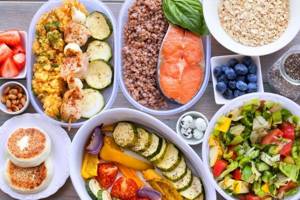
Day 3
- Oatmeal with pieces of peaches, a little cottage cheese, fresh carrots.
- Boiled egg, pear.
- Quinoa with fresh tomatoes and stewed fish.
- Natural low fat yogurt.
- Steamed chicken with vegetables (boiled corn, cucumbers).
4 day
- Scrambled eggs from two eggs, a glass of fermented baked milk.
- A little cottage cheese with pieces of dried fruit (dried apricots, prunes).
- Boiled rice with baked salmon, fresh apple juice.
- Baked vegetables (eggplant, tomatoes, potatoes), a glass of kefir.
- Boiled mussels with watercress.
5 day
- Muesli with natural yogurt, grapefruit, herbal tea without sugar.
- Wheat bran, tomato juice.
- Potato and cauliflower casserole with a piece of cod, one orange.
- Boiled egg, banana.
- Steamed Brussels sprouts and turkey.
Day 6
- Rice porridge on water with fresh raspberries, black coffee without sugar.
- Beetroot-carrot juice and some walnuts.
- Boiled beans with baked trout.
- Low-fat cottage cheese with banana.
- Salad of arugula, carrots, cucumbers and sesame seeds. Grilled beef.
Day 7
- Oatmeal with raisins, freshly squeezed orange juice.
- Pear and apple salad.
- Tomato soup with herbs, baked cod with lettuce leaves.
- Cottage cheese with fruit.
- White cabbage salad and chicken fillet.
Recipes for Gaining Mass and Burning Fat
The healthy foods described in this section are very quick and easy to prepare. Here we use healthy products for weight loss, very tasty and accessible to everyone. Lunch/dinner meals can be prepared in one hour on a Sunday afternoon. Preparing breakfast will take less than 10 minutes. Afternoon snacks are also easy to prepare.
Breakfast to burn fat:
- Option 1: Oatmeal, bananas and freeze-dried protein. While you add water to the oatmeal and heat it up, chop up the banana. Add chopped banana and a spoonful of freeze-dried protein to the oatmeal and stir.
- Option 2: Whole wheat bagel with natural peanut butter, a large glass of milk and a piece of your favorite fruit.
- Option 3: Whole wheat cereal, milk and a spoonful of freeze-dried protein, blueberries and a glass of orange juice.
- Option 4 English breakfast: three-egg omelette with spinach and cheese, a glass of cranberry juice. Buy frozen, chopped spinach. Sauté 1/2 cup spinach in a skillet with a cup of cheddar or pepper cheese.
- Option 5 with greetings from Mexico: burrito with chicken and eggs. Break 2 eggs into a frying pan, add the required amount of canned chicken, cheese and green chilies. Scramble the eggs and wrap everything in 1-2 whole wheat tortillas. Add salsa.
- Option 6: lumberjack breakfast: pancakes and sausages. On Sunday, spend an hour making 5-10 whole wheat pancakes and thinly sliced turkey and/or sausage. Reheat for breakfast throughout the week. Pour natural apple sauce over the pancakes and wash down with a large glass of milk.
- Option 7 Shredded Breakfast: Place 2 scoops of freeze-dried protein in a blender. Add ½ - ¾ cup oats, 1 tablespoon natural peanut butter, water and ice. Stir and drink.
Lunch and dinner to build muscle mass:
- Option 1: Quinoa with salsa and chicken. Add 2 cups raw quinoa to 4 cups water. Boil and reduce heat to evaporate excess water. Remove from heat and let quinoa sit for 5 minutes. Add cooked chicken and 2 cups salsa or other spicy, seasoned tomato sauce. Mix and pour into 5 containers, which will then go into the refrigerator for a healthy and savory lunch or dinner throughout the week.
- Option 2: tuna and pasta. Cook your favorite pasta. Drain and add canned tuna. You can also add peas, low-fat mayonnaise, cheddar cheese and black pepper to taste.
- Option 3: beef and potatoes. Cut 5 large potatoes into cubes. Lightly coat in your favorite seasonings and olive oil and place on the heat. While the potatoes are cooking, add 0.5-1 kg of ground beef (or turkey) to a frying pan, season with salt and pepper to taste and fry. Combine diced potatoes and ground beef. Don't forget to add sour cream or low-calorie sauce.
- Option 4: salmon and rice. Mix three cans of salmon with 5 egg whites. Form cutlets from the resulting mixture and fry them in a frying pan. Place them on a whole wheat bun, a healthy weight loss product, and top with a few onion rings. Cook wild or brown rice with seasonings, or add frozen broccoli. Cooked rice is served along with salmon sandwiches.
- Option 5: Peanut butter and banana sandwich. Spread natural peanut butter on whole wheat bread. Add sliced banana and cover with a second piece of bread to create a sandwich. It is best to eat them with a protein shake (or milk), as well as with a jar of natural yogurt.
You can also easily add canned vegetables or make a quick and healthy salad to eat along with each of these meals.
Afternoons
Don't skip your afternoon snack if you want to burn fat and build muscle! Our afternoon snacks are very easy to prepare.
Remember that snacks exist primarily to help you reach your daily protein intake goals. Protein is vital for muscle recovery and formation, and also helps build muscle while burning fat. An afternoon snack without protein is an afternoon snack in vain!
- Option 2: Protein bar. Keep a supply of protein bars at work, in your car, or in your gym bag. You never know when you'll have to eat on the go. Remember that snacks exist primarily to help you reach your daily protein intake goals. Protein is vital for muscle recovery and formation, and also helps build muscle while burning fat. An afternoon snack without protein is an afternoon snack in vain!
- Option 3: yogurt and almonds. Throw it in the refrigerator and go! One package of yogurt contains 15 grams of protein, and 20 grams of almonds contain 6 grams of protein.
- Option 4: Call this a special store-bought afternoon tea. Take a packet of beef jerky and eat it with a jar of fresh fruit or tomato juice.
- Option 5: cottage cheese and strawberries or blueberries. 100 grams of cottage cheese contain 13 grams of protein and only 111 calories. Mix 200 grams of cottage cheese with a handful of blueberries or wild strawberries, and you have a high-protein, low-calorie afternoon snack.
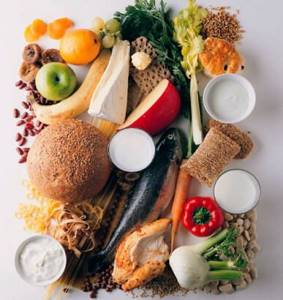
You see, eating to burn fat and build muscle requires a lot of care. But it all depends on your desire. There is also the Dukan diet (how else to burn fat) for these purposes. And, of course, you shouldn’t give up training in the gym!
Sports diet for men
This nutritional system for men is different in that the stronger sex strives not only to lose weight, but also to build strong muscles. To do this, you should follow a few tips:
- A couple of hours before sports, eat a light soup or vegetable salad (large portion).
- Drink a cup of herbal or green tea 30 minutes before.
- 60 minutes after finishing your workout, eat a pear or apple.
- After visiting the gym, eat within twenty minutes.
- Food that helps consolidate the results of exercise: cottage cheese, egg white, boiled rice, chicken breast. It’s better to wash it all down with grapefruit or orange juice.
Eating after workouts isn't completely pointless.
Yes, perhaps the information in the introduction was presented somewhat exaggeratedly. Eating after the gym, in fact, does not pose any serious danger. Athletes most often pay attention to muscle gains, strength, appearance, and whether protein was consumed within two hours or not. When you look at other parameters, what happens after training may not be as important.
When it comes to post-exercise nutrition, one word comes to mind: recovery. Proper nutrition before and after training will not only help you gain muscle faster, but also help you recover more easily after exercise.
One proven aspect of sports nutrition is that consuming carbohydrates within 30-60 minutes of completing a workout allows muscle glycogen to recover faster. If you skip carbohydrates, glycogen is not restored as quickly.
If you consume approximately 1-1.5 g of carbohydrates per 1 kg of body weight 30 minutes after training, you will significantly speed up the muscle recovery process.
Plus, it doesn’t matter whether it’s a super secret liquid shake or a regular meal with rice and potatoes. Either way, this will help maximize the recovery process.
Moreover, this will not only speed up the recovery process, but also increase muscle mass more effectively. Eating protein and carbohydrates helps increase protein synthesis and improve muscle growth.
Sports diet for girls and women
It is slightly different from the same diet for men. The diet is built depending on what goals are set. Most girls, as a rule, want to get a slim figure without pumped up muscles. Therefore they should follow other recommendations:
- Do not consume protein 5 hours before fitness.
- Do not eat anything 2 hours before and the same amount of time after exercising in the gym.
- Only a couple of hours after the workout can you eat food containing protein.

The average caloric content of the daily diet is calculated based on daily needs. To do this, you can use special tables that indicate the calorie content of dishes, or the professional help of a nutritionist.
Protein sports diet for cutting
This diet is prescribed to bodybuilders, athletes and athletes during training.
Its main goal is to remove fat cells from the body, creating conditions for increasing muscle mass and giving it a beautiful relief.
- Food should be predominantly protein. It is allowed to be consumed in unlimited quantities. These are products such as chicken and turkey meat, lean fish, seafood, egg whites, low-fat cottage cheese and kefir.
- The amount of carbohydrates, on the contrary, is reduced to a critical level. And these should be foods with a low glycemic index. They are slowly absorbed and do not store fat in the body. It is very easy to find out the glycemic index of a product; there are special tables on the Internet with all the necessary information.
Here is a list of recommended carbohydrates:
- rye pasta;
- buckwheat grain;
- cabbage;
- tomatoes;
- cucumbers;
- all types of greens.
Drying is not suitable for everyone, but only for healthy and physically fit people. But even a healthy person is better off enlisting the help of a doctor and only then proceeding with it.
It is absolutely contraindicated for people with diabetes, cardiovascular diseases, kidney pathologies, and disorders of the stomach and intestines. A low amount of carbohydrates can lead to apathy, weakness, drowsiness, and inhibition of action. If such signs appear or a taste of acetone appears in the mouth, you should stop immediately.
Drying is always accompanied by regular exercise to keep the skin and muscles toned. A suitable set of aerobic and strength exercises is selected individually by the instructor.
Sports protein diet
Protein is a vital element that should be present in every person's diet. For athletes, protein is even more necessary, as it allows you to build muscle mass and lose weight, without harming your body at all. A sports protein diet is designed to dry the body, strengthen muscles and reduce body fat. It allows you to pump up muscles faster and make your body more prominent.
A protein diet is perfect for those who want to lose weight, build muscle and strengthen it in the shortest possible time. Such a diet should include proteins of animal and plant origin. The required amount of products can be calculated based on your initial weight. For 1 kg. body weight should be at least 1.5 kg. squirrel. The menu should include cottage cheese, low-fat yogurt, eggs, beans, chicken breast, turkey, lean fish, tomato, lettuce, cabbage and vegetables. All food should be divided into 6-7 servings and eaten with a break of 2-3 hours. Water must be included in the diet. It is recommended to drink 1-2 liters of fluid per day.
The effectiveness of a sports protein diet directly depends on the intensity of training and compliance with all recommendations. On average, in a week of such a diet you can lose 3-5 kg.
Sports diet for vegetarians
In recent years, the number of vegetarians has increased significantly. They can also follow a sports diet, but it will be significantly different from the usual one. The fundamental difference is the absence of animal proteins in the diet.
A vegetarian diet and plenty of physical activity will promote hunger. This is good for the weight loss process, but not suitable if the goal is to gain muscle mass. Many people doubt that it is possible to build muscle if you stick to such a diet, but it really is possible.
If a vegetarian has a properly composed diet, he will receive the necessary protein for muscle growth. To avoid a lack of vitamins and microelements, experts advise not to neglect special supplements.
For example, vegetarians are at increased risk for iron deficiency anemia. A deficiency of this microelement limits an athlete's endurance. Therefore, to prevent this from happening, you can take it additionally in the form of a dietary supplement.
The menu must include vegetable oils (olive, coconut, pumpkin, etc.).
Lactovegetarians get their protein from dairy products. Ovolacto-vegetarians are also made from eggs.
With stricter vegetarianism (veganism), protein is obtained by consuming cereals, legumes (peas, lentils, beans), nuts and seeds, mushrooms, vegetables, fruits, berries, and herbs.
To get the right amounts of protein, vegetarians need as much variety in their meals as possible.
The results of the sports diet are impressive - up to 6 kilograms of excess weight are lost in the first couple of weeks. But we must not forget that if you stop exercising and uncontrolled consumption of fats and fast carbohydrates, they will definitely return. Sports nutrition methods are constantly followed; it should become a part of your life.
Content
If you want results quickly and start today, there is no easier way than the 4-Week Muscle and Definition Nutrition Program, based on scientific research conducted by Dr. Jeff Volek, one of the best nutritionists.
In a recent study conducted at the University of Connecticut, Dr. Volek and his colleagues found that a combination of a low-carb diet, special nutrition and strength exercises is an incredibly effective formula for losing fat and quickly improving health. Study participants burned 5 kilograms of fat in a month and successfully gained muscle. One of the guys managed to gain a kilogram of muscle every two weeks, while getting rid of abdominal fat. And, more importantly, study participants were less likely to develop heart disease and diabetes compared to people who followed low-fat diets. Study participants who ate a low-carbohydrate diet and performed strength training saw a reduction in blood cholesterol by 12 percent, triglycerides by 32 percent, insulin by 32 percent, and C-reactive protein by 21 percent. These results were achieved using the muscle building and fat burning exercise and diet program presented in this article.
This 4-week muscle growth and fat loss diet can be considered the first steps towards losing excess weight and achieving health.
This diet is based on simple principles: reducing carbohydrate intake reduces the number of calories you consume, which leads to weight loss. This diet forces the body to use body fat rather than glucose as its main source of energy, which helps control blood sugar levels and hunger.
What to eat Edit
Eat any combination of the foods shown in the table below. You should feel full, but not full. This simple approach will help you control your appetite. As a result, you will be able to eat less and successfully burn fat - without having to watch your caloric intake.
Consume high-quality protein with every meal. Proteins are the starting material for building and repairing muscles, including when you burn fat. In addition, proteins help you feel full faster.
Don't give up dietary fats. Dietary fat is an important factor in controlling calorie intake. They make it possible to maintain a feeling of fullness longer after eating. Don't be afraid to eat fat. As long as you are successfully burning body fat, dietary fat is not a problem for you. Read: healthy fats.
Eat plenty of vegetables. After surveying more than 2,000 people following a low-carb diet, scientists from SUNY City Medical Center in New York found that those who consumed at least four servings of low-starchy vegetables per day had greater weight loss success.
Avoid foods containing sugar and starch. Such foods are rich in carbohydrates. These include bread, pasta, potatoes, rice, beans, candy, carbonated drinks, baked goods, as well as other products based on cereals, flour and sugar. Carefully read the list of ingredients on food packaging. If it contains more than 5 grams of carbohydrates per serving, skip it. However, don't turn this into a mania. When ordering a dish at a restaurant, pay attention only to the main ingredients. Of course, any dish may contain sugar and/or starch, but if the main ingredients are allowed, this is quite enough. Approach this issue without fanaticism.
Healthy food
The most common approach to nutrition in the fitness field is to eat frequently. As a child, you were taught that eating 3 times a day was the best way to eat. The frequent meal diet encourages you to eat less at one time, but each serving should contain protein.
Athletes using this method eat 5-7 times a day every 2.5-3 hours.
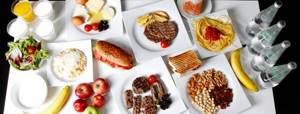
Although frequent meals may seem counterintuitive because you might think that they will lead to fat storage, this is not the case! Keep in mind that over the past 40 years, most of the best physiques in the world have followed this approach.
Frequent meals do not involve huge portions of food 5-7 times a day. Your daily food intake is based on your goals and metabolism. If your goal is to build muscle, you'll eat a little more than usual and simply spread that amount of calories out over the course of the day. If you want to burn fat and build ripped muscles, then you will eat a little less than usual, and also divide this amount of calories among all meals.
Frequent Meal Approach Diagram
Goals: Can be used to build muscle or burn fat, depending on calorie intake.
Meals: Eat every 2.5-3 hours.
To build muscle and burn fat, it is recommended that men eat about 30 grams of protein per meal. If you have 6-7 meals a day, then you can reduce your protein intake to 25 grams of protein at a time. Women need fewer calories per day to maintain their weight, so they don't need as much protein each day. On average, a woman should eat about 20 grams of protein per meal.
Meal timing: Eat the majority of your daily calories in the morning (breakfast) and after your workout.
Complex carbohydrates: Try to include a source of healthy complex carbohydrates in each of your three main meals - breakfast (a must), lunch and dinner. Oatmeal, brown rice, quinoa and sweet potatoes are healthy foods for weight loss as they are good sources of complex carbohydrates.

Healthy fats: Most frequent meal diets recommend getting 20-30% of your daily calories from fat. Small amounts of fat are found in meat (cooked meat) and fish (or seafood). You can also consume fats from eggs, dairy products, almonds (and other nuts and seeds), avocados, olive oil, and natural peanut butter.
The Frequent Meal Approach: It's Simple
Many of us lead busy lifestyles, which can make preparing and including extra meals very difficult. The following template simplifies this entire approach. Please note that the times shown in this template are for reference only. For main meals, focus on appropriately sized portions.
- 7:00 – 1 breakfast
- 9:30 – 2 breakfast
- 12:00 – lunch
- 14:30 – afternoon snack
- 17:00 – dinner
- 19:30 – evening snack
For breakfast:
- 1/3 of your plate should be filled with protein foods (eggs, cheese, milk, cottage cheese, turkey bacon, turkey, sausage, Greek yogurt, you can also eat chicken, fish, beef, etc.);
- 1/3 of your plate should be filled with healthy foods that promote weight loss, such as oatmeal or a whole wheat bagel - sources of quality complex carbohydrates;
- 1/3 of the plate should be filled with fruit. You can also add appropriate vegetables to your breakfast, such as onions, fresh salsa or spinach - all of which go well with an omelet.
For lunch and dinner:
- 1/3 of your plate with protein foods (beef, chicken, fish, etc.);
- 1/3 of your plate with quality complex carbohydrates (brown or wild rice, quinoa, wild rice, potatoes, sweet potatoes, multi-grain breads and tortillas, etc.);
- Fill 1/3 of your plate with vegetables (spinach, broccoli, onions, carrots, eggplant, cucumbers, asparagus, tomatoes (technically a fruit), Brussels sprouts, zucchini, bell peppers, etc.;
